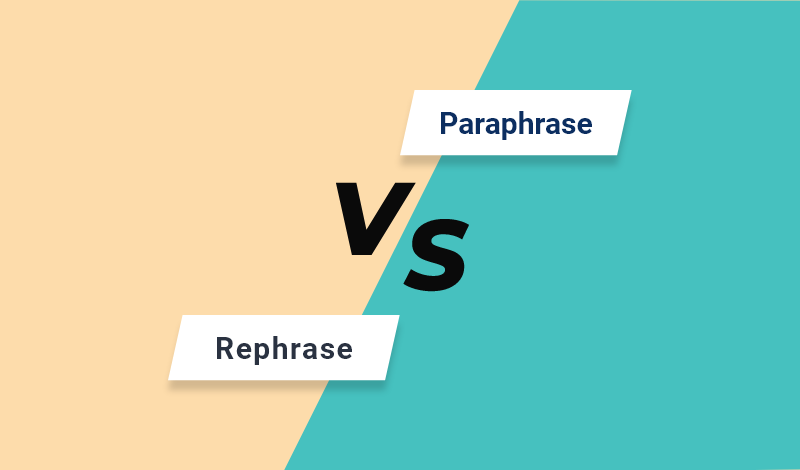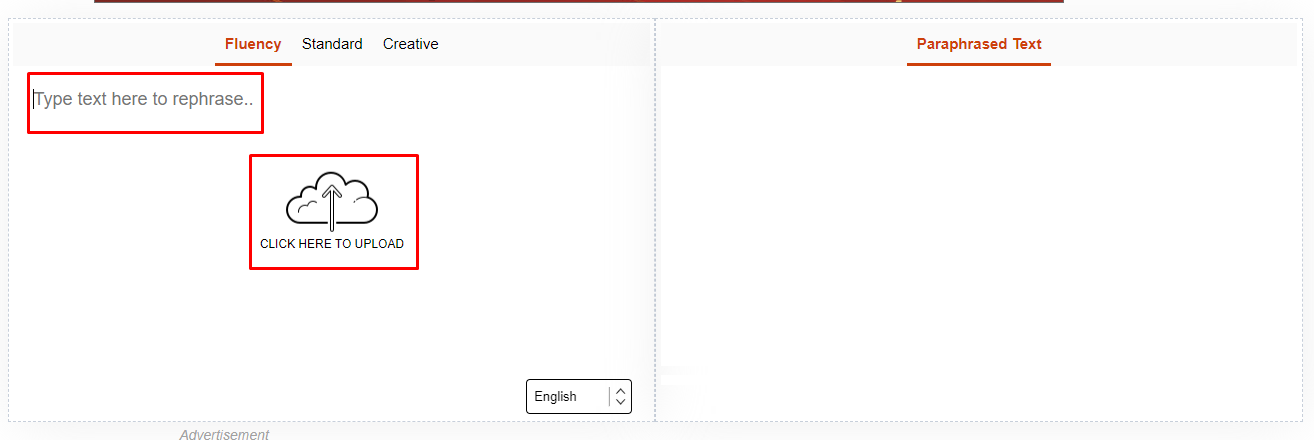
Paraphrase VS Rephrase
Paraphrasing and rephrasing can sound like the same thing, but there are actually some small and fine differences between them. While they're both techniques for rewording existing content, their exact method, as well as purpose, is a bit different.
In this post, we'll be going over what paraphrasing and rephrasing actually are. Then, we'll talk about how you can efficiently use both these techniques and then we'll wrap up with a recommended rephrasing/paraphrasing tool.
Let’s get started.
What is Paraphrasing?
To start off, let’s take a little look-see at what paraphrasing actually is.
There are different ways in which we can define paraphrasing. However, the gist of all of them can be summed up as follows:
Paraphrasing is defined as the process in which existing content is reworded for the purpose of making it look different, but without altering the main meaning/context.
When a piece of content is paraphrased, there are a number of different changes that are made to it. These changes can either be made lightly or extensively, depending on the requirement at hand.
How is Paraphrasing Done?
In order to paraphrase some content, there are various techniques that you can use. For example, when paraphrasing some text, you can:
- change the existing words with suitable alternatives i.e., synonymizing;
- change the phrases;
- change the sentence structures;
- change the tense (past to present etc.) and the voice (active to passive and vice versa).
If you want to change the content in order to make it look completely different from its original version, you can employ all these techniques at once. This can be helpful in situations where you have to completely reword some text in order to use it in your own work e.g., using the results or observations of a particular study in a research paper etc.
On the other hand, if you only need to paraphrase your own content for the sake of improving clarity or removing repetition,
Usually, if the paraphrasing is done extensively, there doesn’t remain a need for citing the source since the reworded version of the text is basically your own work. However, to be on the safe side, it’s better to accredit the source.
Use Cases of Paraphrasing
We did give a small example in the heading above, but let’s look at some more situations that can require you to paraphrase content.
- For content writers, paraphrasing can be required when they find that their work had coincidentally picked up plagiarism by matching with an existing source on the internet. In this sort of circumstance, writers can affect a few changes to their content so that the exact duplication is eliminated.
- Paraphrase in academic writing is often required when the writer has to borrow words from an existing study or research but without quoting them directly. In this situation, citing the source is necessary as well.
- Similarly, writers can resort to paraphrasing when they want to make their written content less hard to read. If, for example, a writer comes up with a blog post that they feel has low readability, they can paraphrase some portions of it to make it more reader-friendly.
What is Rephrasing?
Now that we’re done with paraphrasing, let’s move on to discuss rephrasing.
As far as the basic definition is concerned, there isn’t a lot of difference between rephrasing and paraphrasing. The differences pertain more to the type of use for which they are employed.
Nevertheless, to define rephrasing, we can state it as follows:
Changing a piece of content by altering its words and sentences for purposes such as to improve clarity and/or to shift the point of focus towards a certain aspect etc. is known as rephrasing.
To begin with, the first thing that you will have noticed in this definition is that there is no mention of the context not being changed. And that is, incidentally, one of the factors in which rephrasing differs from paraphrasing. We'll talk more about this later on.
How is Rephrasing Done?
In this regard, rephrasing is, once again, not very different from paraphrasing. The same type of steps that are employed for paraphrasing a piece of content is the same type of steps that you can employ for rephrasing it.
We’ll list them here again, though, so don’t worry.
You can rephrase a piece of text by taking all, or some, of the following steps:
- Changing selected words in the text with appropriate synonyms
- Altering the sentence structures by changing the positions of the object and subject
- Changing the tense
- Adding or removing paragraph breaks
Use Cases of Rephrasing
The following are some instances where you can use rephrasing.
- Rephrasing is usually done on a smaller scale than paraphrasing. Hence, it can be suitable when a writer has to change the wording, structure or order of a specific sentence. In other words, if a writer feels as if the words or the structure of a sentence in their write-up is too confusing, they can rephrase that particular part for better clarity. Actually, read this paragraph again. You'll see we did this exact thing just now.
- Rephrasing can also be useful if a writer detects that a particular sentence in their content is accidentally matching with existing material on the internet. In order to remove the exact replication, the sentence can be rephrased.
Differences Between Paraphrasing and Rephrasing
Now that we’re done looking at what paraphrasing and rephrasing actually are, let’s move on to compare them both and find out the points of difference between them.
We'll look at this comparison aspect-by-aspect, and then we'll present the differences briefly in a table.
1. Utility
The first thing that is different between paraphrasing and rephrasing is the purpose for which they are used.
A lot of times, rephrasing can be done simply to improve clarity in a piece of text. For example, if a sentence is written in a very complicated manner, it can be rephrased so that it appears simpler. For example, this sentence…
The atrocity perpetrated by the conventicle elicited from the populace a hue and cry, which culminated in physical protests and eventually, a coup d'état.
…can be rephrased to this:
The crime committed by the group made the people protest. This eventually led to the people overthrowing the government.
Get the point?
On the other hand, paraphrasing is something that is done a little more extensively. Instead of just being utilized for the purpose of improving clarity, paraphrasing can be done when a whole section needs to be de-plagiarized. Similarly, it can also be used when you have to take some facts from a source without quoting it verbatim.
2. Content Preservation
This is another major difference between paraphrasing and rephrasing.
When a piece of content is paraphrased, it is necessary and essential for the content to remain as it is. The context has to be the same…otherwise, the changes won't be defined as plagiarism.
On the other hand, in rephrasing, since the purpose of changing the sentences can be to improve clarity, some details can be added or subtracted from the original text. This can either shrink the context or increase it.
For example, take this sentence.
John started jumping because the wire he was holding in his hand suddenly became live.
If we want to paraphrase this sentence, we can’t omit anything or add any details of our own. That would change the context. For example, if we were to change the above sentence like this…
John started leaping because the wire he was gripping in his hand suddenly became live. It happened because the person at the control unit turned the switch on.
Now, this is incorrect because the added details change the context. While the original stuff is still there, the unnecessary aberration adds a new thing to the context. A new subject i.e., the person and a subject i.e., the control unit, have been introduced. Due to the transformation in the context, the changes above can be defined as rephrasing, not paraphrasing.
3. Content Used
Normally, paraphrasing is done on someone else's content. Rephrasing, on the other hand, is usually done on one's own content.
For example, if a person wants to take the results or observations from a paper authored by a different person, then they will resort to paraphrasing. But, if someone just wants to tweak a sentence in their own write-up, they will rephrase it.
| Differences | Paraphrasing | Rephrasing |
| Utility | For long-form content | For sentences and passages |
| Context Preservation | Context has to be strictly preserved | Context can be changed a little |
| Content Used | Usually performed on someone else’s content | Usually done on one’s own content |
Suggested Tool for Paraphrasing and Rephrasing: Rephrase.info
Hopefully, at this point, you’re properly acquainted with the differences between paraphrasing and rephrasing. Now, before wrapping this post up, we want to talk about an online tool that you can use for both of these techniques. And that is Rephrase.info.
Rephrase.info is an excellent tool that you can use for rephrasing or paraphrasing your content. It is free to start, and it also has premium plans that you can buy for enhancing the user experience i.e., by increasing the word limit, removing ads and so on.
This tool works smartly to change the entered content. There aren’t a lot of contextual errors, and the output is quite impressive.

There are a total of three modes that you can use with this tool. They are as follows:
- Fluency
- Standard
- Creative
Of these three, the Creative mode is for paid members only.
Other than the availability of multiple modes, there are a number of other features that you can enjoy with this tool as well. We’ll look at those in a little. For now, let’s take a look at the steps that you have to follow in order to use this tool.
How to Use Rephrase.info
Here is how you can use this tool:
- To start off, you’re going to have to enter your content into the provided field. You can either enter it directly by typing/copy-pasting, or you can upload a file from your device instead. If you are on a free plan, you will only be able to add 500 words at a time. You can, however, increase it to 1,500 by purchasing the paid plan.

- Then, once the content has been imported, you can select your required mode from the top of the input box.

- If you want, you can also select a language before starting the process. This applies if the content that you’re trying to paraphrase or rephrase is in a lingo other than English.

- Then, once the above is all done, you can move ahead to complete the captcha, and start the process. That’s pretty much it.
Features of Rephrase.info
The following are some excellent features that you can enjoy with Rephrase.info.
- Intelligent and smart working
- Multiple languages supported
- Multiple modes available
- File uploads supported
- Useful post-processing options (copy, download, clear field etc.)
Conclusion
And there we have it.
Rephrasing and paraphrasing are two similar-sounding yet different techniques that you can employ when writing content. In the post above, we looked at some of their differences in detail.
In a nutshell, the main difference between rephrasing and paraphrasing is that the latter is usually performed on large bits of content whereas the former is for individual sentences or small passages. Similarly, when paraphrasing a piece of text, the context has to be incumbently preserved, whereas there is a bit of leeway in this regard when it comes to rephrasing.

